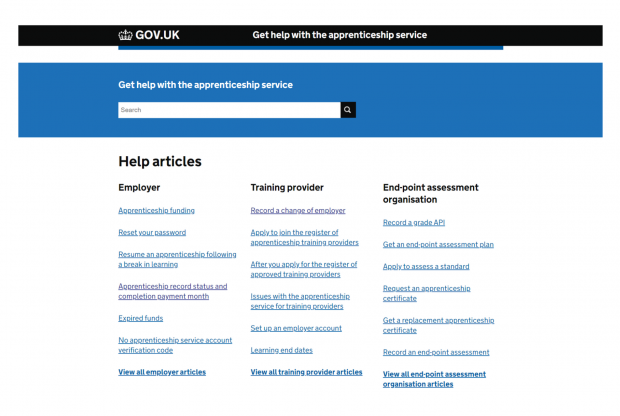 In part 2 of their blog, the apprenticeship service support team look at service transformation and a 'digital by default' model. They also explain how this model enabled them to respond to the challenges posed by the Coronavirus pandemic.
In part 2 of their blog, the apprenticeship service support team look at service transformation and a 'digital by default' model. They also explain how this model enabled them to respond to the challenges posed by the Coronavirus pandemic.
Online self-service
As our team created content for knowledge articles to form a searchable help centre, we explored different ways to publish this information and ‘surface it’ to our users. This led to the introduction of a number of self-service features including:
- searchable articles
- contextual help
- chat bot
Chat bots and artificial intelligence (AI)
These self-service features allow our users to get the help they need, whenever they need it. As well as being able to search for help on any given topic, a tracking system means contextual help information will pop up on a user’s screen when the system notices they have been on the same page in the service for a lengthy amount of time. It prompts users to seek support if they need it, signposting them to our service support options.
We have a real-time view of where our customers are within the service – represented as blue dots on a visual map. This gives us a real understanding of customer journeys as we can track how they use our services. This valuable and instant data allows us to be far more agile and responsive, alerting us to any problem areas where an issue arises that affects multiple users.
We have also launched a chat bot that uses AI to respond to user queries using web chat. This low cost approach means all customer queries through web chat are initially answered without human intervention, resulting in simple queries being resolved without needing to be escalated to a member of the contact centre.
This makes accessing support much faster for our users and frees up contact centre staff to focus on more complex tickets, whilst saving money within the service.
Continuous improvement
The chat bot, powered by AI, is improving all the time, drawing its answers from knowledge articles and getting better at understanding customer queries the more queries that pass through it. Customers can rate the support provided and give feedback, helping us to monitor the impact of specific knowledge articles and evaluate how well the bot is working.
We continue to use data from Zendesk to make decisions about what knowledge article content we should work on, and to gain an in-depth insight into how well existing content is performing and to identify improvements or information gaps.
If several hundred users have looked at an article and 75% of those providing feedback have rated it as ‘thumbs up’, their query has been resolved, then that content is working well but could do better. This data-driven approach enables us to be smarter about where to focus our energies and to be much faster in our response times.
Our monthly data shows that since system go-live in September 2019, we have managed to ‘channel-shift’ many of our end users from telephone contacts (expensive) to web chat and self-service (low cost), saving thousands of pounds of taxpayers’ money.
Since we switched on the AI function in January 2020 it has assisted users in resolving issues without them ever needing to speak to a member of the team.

Building insight with data
Using Zendesk, our team has a rich source of feedback on exactly what users are saying, the problems they face, and when and where they are encountering issues. But measuring feedback is meaningless unless we act on what we learn.
We continuously monitor and review feedback that relates to our support offering, look at quantitative and qualitative data from Zendesk, and combine this with other tools such as Google Analytics, to capture a 360º view of our users.
This enables us to evaluate the apprenticeship service as well as the support model we run, helping us to seek out new ways of offering customer support and identifying the improvements that will really make a big difference to the majority of our customers. Customer priorities and experiences in the service, become our priorities in support.
And this is just the start.
We’ve built a very close relationship with the apprenticeship service continuous improvement team. Our rich data and insights highlight problem areas within the service and colleagues can act on this information to help fix problems at source.
An agile response to Covid-19
When the impact of the Covid-19 pandemic began to surface, the apprenticeships team within the Department for Education responded rapidly to introduce policy flexibilities, such as the modification of end-point assessment arrangements, including remote assessments, and apprentices on furlough being encouraged to use that time to continue their off-the-job training where possible.
To support the communication and understanding of these flexibilities, the apprenticeship service support team worked quickly to create a set of new knowledge articles specifically related to the challenges of delivering apprenticeships within the context of lock-down.
These articles were organised by user groups – employers, training providers and end-point assessment organisations – but it soon became apparent that more and more apprentices were getting in touch with our support services, looking for help during furlough and potential redundancy situations.
In response, the support team wrote knowledge articles specifically for apprentices and to date, this self-service content has had more than 16,000 views.
Since March 2020 and the release of Covid-19 specific knowledge articles for all our users, this content has been seen over 28,000 times, At the same time, calls to the contact centre have reduced significantly, demonstrating a channel shift and behaviour change from our users.
Our current feedback from customers is that 81% rate our customer service as good. It has been heartening to see that even during a national crisis affecting every part of people’s lives, our new support service model has stood up to the test, delivering support that is digital by default and empowering users to self-serve as much as possible.
You can take a look at our online help centre here.